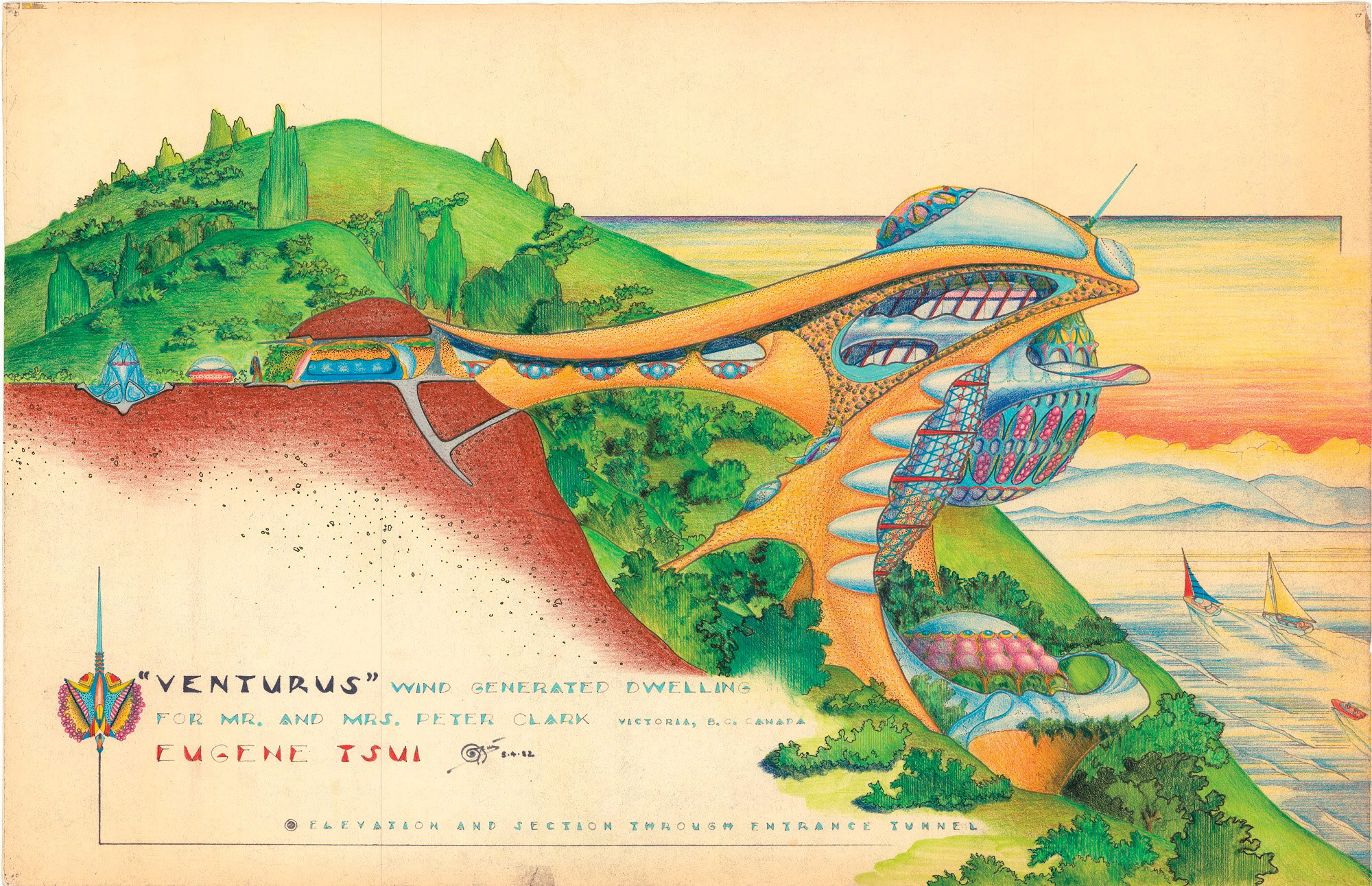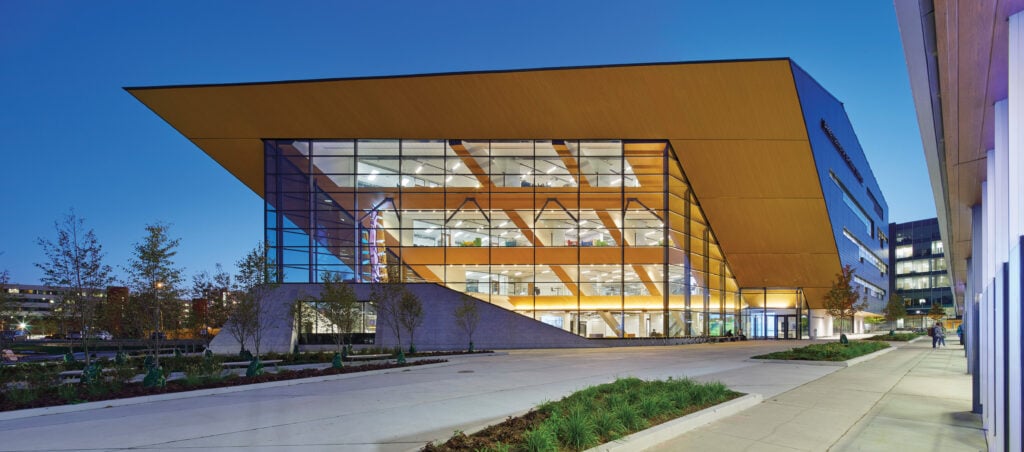
February 27, 2024
MoMA Misses the Roots of American Environmentalism

This context casts a bleak shadow on what otherwise would be an inspiring and long-overdue survey of America’s unique architectural reactions to the environmental crisis during the 1960s and 1970s.
Emerging Ecologies was curated by Carson Chan, MoMA curator and the inaugural director of the Emilio Ambasz Institute for the Joint Study of the Built and the Natural Environment, which was established in 2020 within the Department of Architecture and Design to conduct research and organize exhibitions and programming on the built environment and environmental justice. The exhibition is the institute’s inaugural offering and features over 150 works including models, photographs, diagrams, sketches, video, and audio that represent built, speculative, often-fantastical, often-dystopian projects in the United States throughout the late 20th century. The institute has initiated other programming including a six-part panel discussion series titled “Circular Museum,” in which MoMA aims to interrogate “how museums and cultural workers have—and can—consider and implement circular and sustainable museological practices.”

Countering Modernism
From the start, the curatorial team states that Emerging Ecologies is a “focused survey” on the countercultural movement that went against mainstream architectural Modernism. The introductory wall text reads: “To be sure, ecological knowledge of the U.S. did not start with architectural efforts in the last century. For generations before European colonization, Indigenous communities tended to the lands around them.” And that’s about as much as they say about anything that isn’t in dialogue with Modernism.
But even within its scope, the show offers little clarity. Through examples such as Buckminster Fuller’s Dymaxion Dwelling, the Eames Office’s 1966 National Fisheries Center and Aquarium, and James Wines’s provocative Highrise of Homes drawings, Emerging Ecologies claims to provide lessons for how we might approach the climate crisis today. But these lessons are painful to piece together—the confusing layout, hard-to-read labels, and important written and audio information obscured behind walls bury a lot of information and may leave visitors overwhelmed and confused.
The curatorial team did attempt to include a dense timeline of the movement, but it’s also hidden by an elevator bank, which, to be fair, is a secondary entrance to the exhibition. The show’s main entrance (into the infamously named Philip Johnson Galleries on the third floor) notably features little to no information besides the exhibition title. And given how freely museums have been providing land acknowledgments over the past few years, it’s also a little odd that there isn’t one in sight, let alone anywhere on MoMA’s website. For the record, the museum sits on unceded land of the Lenape peoples.
All these seemingly minor critiques point to a major problem that architectural exhibitions have faced since their inception: How can museums exhibit architecture in a way that informs and inspires without having visitors read hundreds of words on a wall-text, listen to hours of audio or lectures, watch the accompanying YouTube video, or purchase and read an 80-page publication to get to the message that should be delivered—our extractive building industry, the destruction of Indigenous land, and the erasure of traditional wisdom are killing our planet?
Extensive reading is exactly what visitors will have to do if they are looking for a stronger stance from the Ambasz Institute on any of the issues at hand. In a beautifully designed and guest-edited issue of Atlanta-based publication Art Papers titled “Counter Ecologies,” the institute attempts to fill in some gaps. It’s a lovely publication to accompany the equally impressive exhibition catalog and features far more perspectives than one will find in the galleries, including interviews with material scientist Mae-ling Lokko and SCI-Arc cofounder Glen Small, as well as previously unpublished sketches and notes from unsung visionaries of the exhibition such as Eugene Tssui and architect Phyllis Birkby.

The Lost Legacy of Ecofeminism
At MoMA, once visitors make it past the exhibition’s more predictable canonical inclusions (a model of Frank Lloyd Wright’s Fallingwater and Fuller’s World Game project are among the first artifacts they are confronted with), they will stumble across a 13-foot scroll of drawings organized by Birkby in the Women’s Environmental Fantasies Workshops she conducted throughout the 1970s.
In the workshops, Birkby asked women to sketch what their ideal living environments looked like without any constraints. Most of the women she knew were from feminist, art, and literary circles, nearly all of them identifying as lesbians. She asked: What does the environment look like? What size and shape? What is it made of? Where is it located? What do you do there? Is anyone else there? And she believed that drawing would help women tap into their desires that were looked down upon by the patriarchy, noting that architecture and the built environment were obviously instruments of patriarchal (and colonial) power.
Birkby’s later work focused on “women’s vernacular architecture” where she often researched Indigenous architecture built by women themselves, including Rain Parrish, a Navajo artist who constructed a traditional hogan—a hut made of clay and branches. This, however, isn’t information you will find in the show.
Despite her deep and provocative worldview, Birkby did succumb to one of the fads of her time. Architecturally, the most common form found in her environmental drawings is the dome. The geodesic dome was originally conceived by Fuller, and as the exhibition makes clear, it grew popular in the communal architecture of the 1960s and ’70s. Bill Voyd, a resident of the influential commune Drop City, once said: “To live in a dome—psychologically—is to be in closer harmony with natural structure…. Corners constrict the mind. Domes break into new dimensions.”

Failed Domes and Dreams
Throughout the exhibition, visitors will get an in-depth look at various domes across the 20th century, from Fuller and CambridgeSeven’s Expo 67 U.S. Pavilion, to the Missouri Botanical Garden’s Climatron, to more DIY projects from the likes of the New Alchemy Institute that evoke the legends of self-build publications such as Stewart Brand’s Whole Earth Catalog and Lloyd Kahn’s Shelter.
The dome continues to have a hold on the architectural imagination. This past September, the Madison Square Garden Company opened “the world’s largest Spherical structure,” a $2 billion project in Las Vegas aptly called Sphere. Sphere features an 18,600-seat auditorium and an exterior consisting of 580,000 square feet of LED displays in which it can project any image from the surface of Mars to giant eyeballs to American flags. Allegedly, the building will run on 70 percent solar energy, with any energy from nonrenewables being offset by carbon credits. Even if that is the case, this hardly accounts for the sheer number of materials it took to build the thing, not to mention the light and noise pollution it emits, among numerous other environmental concerns.
It raises the question: Has America learned a single thing from all the “failed” and unbuilt dome experiments from its past that are on view at Emerging Ecologies? Perhaps we must return to the lessons learned by DIY builders such as Kahn. In a recent interview, the 88-year-old architect said: “I concluded that [domes] didn’t work out. I took the dome down and Domebook 2 out of print, even though it was selling well. When I called my agent, he thought I was crazy, but I just didn’t want any more domes on my karma. Admitting you’re wrong in front of a couple of hundred thousand people is not something that you really want to do. But I did. I said, look, I made a mistake and I am sorry about that. It just doesn’t make any sense to do a building from an abstract concept like an icosahedron or polyhedra. It’s not worthwhile as a basis for construction.”
This failure is hardly acknowledged in the show, which is hesitant to point out the shortcomings of both the historical ideas it showcases and of contemporary architecture. Overall, Emerging Ecologies, packed full of exciting projects, leaves a lot of questions unanswered. To be sure, the curatorial team appears to be hard at work attempting to right some of MoMA’s oversights with an overabundance of materials, research, videos, lectures, and summits. How can we bring these conversations into the galleries themselves, available for processing by the general public? Why are we so timid about the ways in which we exhibit architecture and speak out against the ills it continues to perpetrate? For an institution that has shaped the discourse around Modern architecture in this country, MoMA needs to do better about using its platform (and money) to express the urgency of the climate crisis. Is this show a step in the right direction for MoMA? Perhaps. But these conversations have little impact until those in power start divesting from fossil fuels and stand for proven regenerative solutions. Until then, the “circular museum” means nothing.
Life Cycles: The Materials of Contemporary Design
SEPTEMBER 2023—JULY 2024
After taking in the utopias (and dystopias) on view in Emerging Ecologies, museum visitors can go downstairs to MoMA’s street-level gallery to see how contemporary designers are engaging with “innovative, sustainable, and responsible use of materials.” On view through July 2024 and curated by senior curator Paola Antonelli alongside curatorial assistant Maya Ellerkmann, the exhibition showcases approximately 80 contemporary design works from some 40 designers who are considering the full life cycle of building materials—from extraction to reuse.
The most striking work on view is Mae-ling Lokko’s Handprints, a commission of a wall panel made of hemp, kenaf fibers, and fungal mycelium.
An architectural scientist from Ghana and the Philippines, and a professor at Yale, Lokko also provided audio for Emerging Ecologies, and a Q&A with Eva Lavranou, an intern at the Ambasz Institute, for the accompanying Art Papers issue. In the piece she discusses material reuse, providing her perspective on the 1970s experimental beer-can brick “Earthship” architecture of Michael Reynolds, which is on view in the show upstairs.
“For me, Reynolds brought to the surface this critical issue in our modern material economy around the fact that the end of life of the material wasn’t something that was critically thought about or designed for,” she says. “In his view, everything from the beer can to the rubber tire became a new natural resource. The fact that, today, the problem is the solution, that ‘waste is the resource.’”

Would you like to comment on this article? Send your thoughts to: [email protected]
Latest
Profiles
Ifeoma Ebo Is on a Quest for Urban Healing
Through trauma-informed design processes, Ebo aims for community stewardship and empowerment.
Products
Autodesk’s Forma Gets You Ahead of the Curve on Carbon
Autodesk Forma leverages machine learning for early-phase embodied carbon analysis.
Products
Eight Building Products to Help You Push the Envelope
These solutions for walls, openings, and cladding are each best-in-class in some way—offering environmental benefits, aesthetic choices, and design possibilities like never before.





